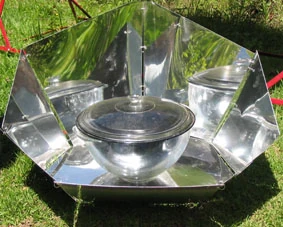| Line 84: | Line 84: | ||
| − | + | Another interesting design created by one of the prolific designer Teong Tan of Mayasia. He realized that a cooker with an aperture at 60 degrees capturers most of the sun shine, as in the Funnel cooker of Steven Jones of US. But Funnel cooker is unstable, and hence Teong designed a new cooker called 'Fun-panel' combining the best features of Funnel cooker as well as cookit. The design sure appears attractive, and preliminary studies indicate that it performs well. Readers who are interested in making the cooker may please visit his well created site at http://www.freewebs.com/sunnycooker/funpanelcookerplan.htm |
|
Teong is a very concerned and devoted Solar Cooker specialist and some of his other designs like Dual-Angled-Twelve-Sided cooker (DATS) solar cooker have already been added to this site. |
Teong is a very concerned and devoted Solar Cooker specialist and some of his other designs like Dual-Angled-Twelve-Sided cooker (DATS) solar cooker have already been added to this site. |
||
Teong has conducted comparative study on green house enclosures as well, and finds that Dar's hot pot works well. Details can be found in his site mentioned above. (Study detailed in solarcooker.org site as well)</font></p> |
Teong has conducted comparative study on green house enclosures as well, and finds that Dar's hot pot works well. Details can be found in his site mentioned above. (Study detailed in solarcooker.org site as well)</font></p> |
||
| − | [[Image:Funpanel. |
+ | [[Image:Funpanel.jpg|thumb|151px|Fun-Panel Cooker|right]] |
==Dual Angle Cookers== |
==Dual Angle Cookers== |
||
Revision as of 12:36, 27 April 2008
|
The original author of this article is Dr. Ashok Kundapur. Find more of Dr. Kundapur's work on his website: http://www.solcooker.net/Cindex.htm. |
| Next: Indirect cookers |
Template:Compendium TOC
Panel Cookers, due to their ease of construction and low-cost material, may be the most common cookers available.
CooKit

In the year 1999, another very interesting but very simple and effective design, a very low cost solar cooker was presented by Prof. Roger Bernard (1995) of France. Brand named CooKit, it is just a packet of interconnected reflectors. When open, they fold out into a small bracket of reflectors around a central space where a cooking vessel is kept in a transparent container of a heat resistant plastic. The cooker, probably the simplest among the lot, is cheaper than that of the VITA design, works well, and is one of the most popular solar cookers on the planet.

Plan details of the CooKit
The popularity of this design has compelled the reviewer to include more details regarding the same. Professor Bernard, the designer of this unique and most simple design has brought out a book in French where he has presented many more simple designs. The CooKit is to be cut out from a cardboard of about 1 x 1.25 meter. Other material also can be used, for example polished aluminium or stainless steel. After cutting the cardboard as directed, aluminised Mylar or aluminium foil is stuck to it. It is then folded and as shown and prop-it-up, and lo, you have the cooker ready.

When reviewer tried to make one CooKit some difficulties were experienced, especially with reference to round cuts at the top reflector and other details. Hence he tried to make the whole design simpler. The central part would be about one to one-and-a-half inch (5 to 7.5 cm) larger than the cooking vessel. Rest of the design is easier to draw on the flat cardboard and cut out the CooKit. It would be possible to calculate precisely the angle at which the reflector at the back should be, for various latitudes. The angle thus established will have to be incorporated in the design, and once it is cut, it can not be altered easily.

The cooking pots have to be kept inside a suitable transparent cover. Simple transparent plastic bag even of Polyethylene has been found to work, called greenhouse enclosure. Such an enclosure was suggested by the legendary Mrs. Barbara Kerr. Professor Bernard himself had suggested use of a inverted transparent bowl around the black cooking pot. Later considering several problems associated with such a transparent cover around the cooking pot, he had suggested use of upright transparent bowl of a size larger than the cooking pot and had also suggested several other modifications for easy cooking.
The glass bowl concept has been developed by David and recently by Darwin Curtis of Solar Household Energy (SHE).
Mr. David Delaney of Canada has come out with a wonderful idea detailed here. David uses a glass bowl larger than the cooking vessel. To keep the vessel inside the bowl, a thick cardboard collar, with a hole to accommodate the bowl, is used as shown in the diagram. To keep a smaller bowl for cooking, a collar with smaller hole can be used.
The diagram gives a clear picture as to the assembly of black cooking pot in a CooKit.
Carrying this concept of glass bowl, recently Darwin Curtis and Louise Meyer of SHE have come out with a specially designed HotPot of glass surrounded by foldable sparkling reflector panels. They have won a grant from the World Bank to distribute this type of cooker.

Glass bowls are costly. In India they cost about Rs 500/-. In Africa too, glass bowls would be costly, so recently Mr. Diasanna, the ingenious down-to-earth inventor from Nigeria, devised a simple and effective enclosure of transparent plastic to cover the cooking vessel from the top. To retain the shape of such a cover, used thick copper wire, or the like. (See the diagram in the composite sketch bellow). The reviewer has suggested some improvement over Mr. Diassana's Cover. The design of transparent enclosure I suggest comes in two parts. First part is a transparent cover, cylindrical is shape, and a size bigger than the cooking vessel, slightly taller too. This is suitably supported by thin but strong sticks or copper or aluminium wire. The top of this enclosure has a Chinese hat like transparent cover, which is also supported by a wire at the edge only. I have sent the details to the Solar Cooker Review, and so the design should see the light of the day. I shall now present the plans and drawing for the construction.
CooKit variations

Design variations
Professor Bernard's CooKit is becoming more and more popular. To increase the efficiency of such cooker, the angles of the reflectors have to be altered to suit latitude. A large number of CooKit variations have been suggested. Some of the most available are presented here.
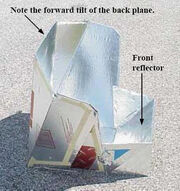
High Backed Cooker
The Florida Solar Energy Center has developed the High Backed Cooker. Their Florida test indicate that it performs better than the regular CooKit at that location. It is a special adaptation for regions at higher latitudes than 35°. Additionally, this group has done excellent work on various aspects of solar cooking, like selecting good reflectors, transparent materials for "green house" enclosures, and back support for the CooKit cooker.[1]
Mr. Teong Tan working at Malaysia has evolved another variation to Cookit. The Dual Setting Panel Cooker (DSPC) was specifically designed for the high altitude sun angle near the tropics.
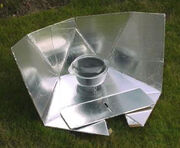
Dual Setting Panel Cooker
In 2006, Derris suggested an interesting variation, the Pyramid cooker. For the sake of convenience it can be classified under panel cookers.[2]
The Pyramid cooker, an interesting and apt name indeed, is said to perform better than the CooKit. As shown in the photos the two sides of the pyramid are made of reflector material, and the front is covered by a transparent plastic. A third, adjustable reflector is in front.
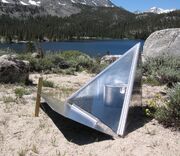
Pyramid Cooker
Funnel cookers

Jones Funnel Cooker
Professor Steven Jones has another interesting variation which he calls the 'Funnel Cooker'. The Funnel Cooker has several advantages. It is simple to construct and store, and there is hardly any wastage of sheet. Supporting the funnel may pose problem in the beginning but one can easily solve the problem, with, for example, a small hole in the ground to hold the base of the funnel. Two small sticks or stones could be propped up at the back to hold the funnel in the right position.[3]
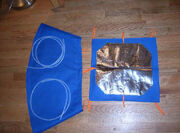
Baker Funnel Cooker
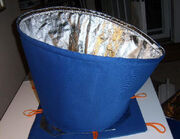
Baker Funnel Cooker
Molly Baker has presented another interesting variation of Funnel cooker. The cooker is made from stiff cloth and the inner lining is a reflector material, perhaps like the one produced by Derris of Clear dome Solar. When the fold is opened and plastic tubes are inserted at the top and bottom the cooker forms a stiff cone ready to cook. The innovator has not shown a green house enclosure, but the cooker will perform better with one.[4]
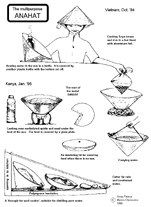
Anahat Cooker
Anna Pearce has modified the cone shaped hat of the far east regions into a multipurpose device which can be used as hat (headwear), as a vessel to cook food and carry water, and also as a cone-type solar cooker called Anahat cooker.
Most of such cookers would work very well, there are reports indicating that they have worked even in remote areas like Nepal. But many appear to be rather small for the reviewer, bigger reflectors should work better.
Richard Pocock of South Africa has been working on solar cookers for over 17 years, and has evolved two very interesting designs 'Pentagon Star' and 'Suncatcher'. Of this I would detail on Suncatcher. As the inventor claims, though the design looks like a variant of 'Cookit' it has been evolved independently from parabolic cooker. He wanted to make the parabolic cooker simpler, probably, and had ultimately landed on sun catcher design. As the photo would depict, the design does convey more sun light to the cooking pot, though most of it is from above as in the 'cookit' type of designs.

Suncatcher Cooker
Richard Pocock's site describes plans to make Suncatcher, readers can buy from him the design as well (http://solarcooking.wikia.com/wiki/Richard_Pocock)
Another interesting design created by one of the prolific designer Teong Tan of Mayasia. He realized that a cooker with an aperture at 60 degrees capturers most of the sun shine, as in the Funnel cooker of Steven Jones of US. But Funnel cooker is unstable, and hence Teong designed a new cooker called 'Fun-panel' combining the best features of Funnel cooker as well as cookit. The design sure appears attractive, and preliminary studies indicate that it performs well. Readers who are interested in making the cooker may please visit his well created site at http://www.freewebs.com/sunnycooker/funpanelcookerplan.htm Teong is a very concerned and devoted Solar Cooker specialist and some of his other designs like Dual-Angled-Twelve-Sided cooker (DATS) solar cooker have already been added to this site.
Teong has conducted comparative study on green house enclosures as well, and finds that Dar's hot pot works well. Details can be found in his site mentioned above. (Study detailed in solarcooker.org site as well)
Fun-Panel Cooker
Dual Angle Cookers
There seems to be renewed interest in this type of solar cooker that shares some of the properties of panel cookers like the CooKit and of parabolic cookers.
DATS
Mr. Teong Tan fabricated what he calls as DATS meaning Double Angled Twelve Sided Solar cooker. The motivation for this design was mainly to avoid the transparent plastic enclosure/guard around the cooking pots that is used to reduce heat loss.
Parvati Cooker

Parvati Solar Cooker
In India, Mr. Ravendra Pardeshi and his wife Mrs. Shobha, of Pune developed a similar cooker, the Parvati solar cooker (named after the inventor's grandmother). It is clear from perusal of their site that they took the clue from Professor Mannan’s improvement of VITA Design. But to start with they had fabricated Professor Jone's Funnel cooker and then settled upon the Parvati design. The two photograph/drawings presented here (Ravidra Pardesi's site) illustrate this cooker. It is commendable, that this concerned and highly motivated husband and wife team have done lot of experiments and have suggested that stacking the vessel one above the other gives better results than placing them side by side.[5]
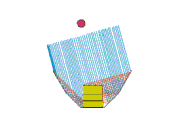
Pardesi Double Funnel Cooker
Mr. Ravindra Pardesi and his wife Shobha have developed new design, an improvement over Jone's funnel. It is a double funnel. They have introduced a ray trace diagram, which calls for immediate attention by all the solar cooker designers and reviewers requesting them to make such diagrams for all the types of cookers they evolve. This is a very interesting and useful drawing. The author's special compliments go to Mr. Ravindra and his wife Shobha on creating such a wonderful drawing.[6]
External links
- Evaluation of Several Original and Commonly Used Solar Cooker Designs - Dane Dormio and Dr. Steven Jones
- Main article: Compendium of solar cooker designs
| Next: Indirect cookers |

